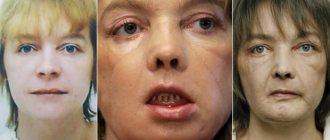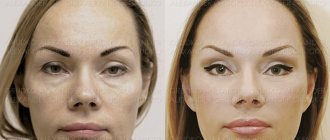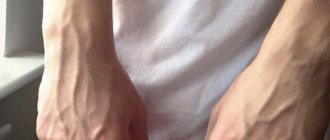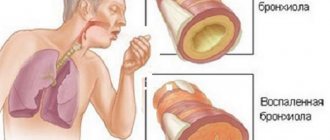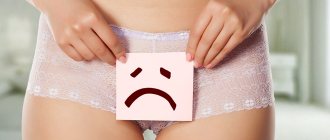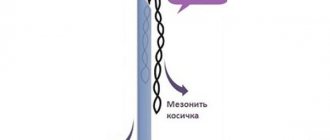Cosmetic surgery operates with a large number of terms that are incomprehensible to the common man. Rhytidectomy of the skin of the face and neck, what it is and why we need it, we’ll look into it in detail.
Every year the shape of our face and the condition of our skin changes. In youth, it looks more like a triangle with the apex at the chin. Over the years, the situation changes, and by a certain age you may notice how the top of the forehead becomes the top of the triangle, and the cheeks become the base. The face begins to gradually slide: the shape of the eyebrows changes, the corners of the eyes droop, the nasolabial folds become pronounced, the cheeks lose their elasticity, and a double chin appears.
How the stars of Soviet cinema and Hollywood age, see here...
The natural biological process of skin aging is individual; it is impossible to say at what specific age this occurs. Once you notice these changes, you can slow them down by maintaining a healthy lifestyle. But this does not always work out. Many modern procedures help restore youth to the skin of the face and neck, one of which is rhytidectomy.
What's happened
Rhytidectomy of the skin of the face and neck is a type of surgical intervention, the purpose of which is to correct the first signs of aging. The operation takes place under general anesthesia. Thanks to the method, you can remove wrinkles, a double chin and other defects associated with age-related changes.
After circular facial plastic surgery, the clarity of the oval is restored, pronounced wrinkles on the cheeks are eliminated, the overall appearance of the skin in the neck area improves, and drooping eyelids are lifted.
The rejuvenating procedure has no age restrictions. However, it is not recommended for people under 20 and after 70 years of age. Typically, the first plastic facelift is prescribed between the ages of 40 and 50.
Facelift using subperiosteal lifting
The subperiosteal face lift technique is performed by vertically lifting the soft tissues of the face, completely separating them from the underlying facial bones and lifting them into a more aesthetic position, correcting deep nasolabial folds and sagging cheeks. The technique is often combined with standard techniques, which ultimately provides effective and long-lasting facial rejuvenation in all age groups. The difference between this and other lifts is that after the subperiosteal facelift procedure there is a longer recovery period associated with prolonged soft tissue swelling.
Indications
Surgery is performed if there are the following problems:
- pronounced nasolabial folds ;
- drooping eyelids and corners of the eyes;
- vertical cords;
- shaved;
- lack of clarity of contours ;
- formation of a double chin ;
- sagging skin in the cheeks and neck;
- wrinkles;
- loss of firmness and elasticity of the epidermis.
The operation is also performed if the oval of the face “floats”.
Contraindications
You cannot do a circular lift if:
- cancer;
- clotting disorders ;
- infections;
- decreased elasticity ;
- diseases of the heart and blood vessels, occurring in acute form;
- diagnosed diabetes mellitus ;
- breastfeeding . _
On this topic
- Lifting
Vector lifting
- Olga Aleksandrovna Kalinina
- October 21, 2020
In addition, the procedure is contraindicated during pregnancy.
If the patient has a predisposition to the formation of keloid scars, then this type of surgical intervention will also have to be abandoned.
Who is rhytidectomy indicated for?
Typically, a circumferential lift is performed at the age of 45-60 years. But the main indication for it is the condition of the skin on the face and neck. It can sag, and muscles can lose tone under the influence of an unhealthy lifestyle and genetic predisposition, and much earlier.
The specialist will advise resorting to rhytidectomy if:
- the contours of the face were deformed, the skin on the cheeks or in the chin area sagged;
- the nasolabial furrows and folds running from the corners of the lips to the chin sharply deepened;
- the fat layer has shifted;
- muscle tone weakened and a “double” chin appeared;
- The shape of the neck changed, the skin on it became covered with wrinkles.
Up to 40 years of age, surgery is performed on individual problem areas on the face and neck. Its effect is pronounced and persistent, which is due to the natural age-related characteristics of the epidermis. It still retains elasticity, and wrinkles have not reached a critical depth.
Patients over 40 years of age require more extensive intervention using the SMAS lifting technique.
The operation will not be possible if:
- diabetes mellitus;
- exacerbation of chronic forms of pathologies;
- high blood pressure;
- joint diseases;
- acute stage of any disease;
- diseases characterized by decreased blood clotting;
- serious pathologies of internal organs, accompanied by a disorder of their function;
- dermatological diseases localized at the site of potential intervention.
Preparation
Circular facelift surgery involves preparation. First, the patient comes to a specialist for an examination, during which the doctor assesses the general condition of the skin, determines the range of problems that need to be solved, and gives a referral for a diagnostic examination.
Surgery will be refused if there are no results for the following types of diagnostics:
- blood and urine tests
- biochemistry to determine the concentration of bilirubin, potassium, urea, glucose, total protein, sodium, AST and ALT;
- coagulogram;
- electrocardiogram;
- analysis for Rh factor and blood group, syphilis and HIV;
- fluorography.
You need to pay attention to the period of the menstrual cycle. The operation is not performed at the time of menstruation and 4 days before and after it.
Approximately 14 days before a plastic facelift, you need to stop smoking, drinking alcohol and taking medications that help change the level of blood clotting.
One day before the appointed date, it is forbidden to eat fatty foods. You can eat easily digestible food, but no later than 8 hours before the intervention.
On this topic
- Lifting
Short scar facelift
- Editorial board of Plasticology.ru
- October 21, 2020
On the day of execution, you need to wash your hair and remove any remaining makeup from your face.
All these measures contribute to successful implementation, obtaining the desired result and preventing the development of undesirable consequences.
Execution order
Facial skin tightening is not a particularly complex operation, but it requires preliminary preparation. The last meal and liquid intake should take place at least 6 hours before the procedure. The doctor may ask you to quit smoking 1.5 months before the planned session. This will speed up healing and reduce the chance of scarring and other complications.
Before surgery, you should be careful when taking medications: aspirin, anti-inflammatory drugs, vitamins and homeopathic compounds can cause severe bleeding.
For rhytidectomy, it is best to be hospitalized, although it can also be performed on an outpatient basis. The length of hospital stay is determined by the patient's condition. Usually it lasts a day, but it can last longer.
For pain relief, general anesthesia is most often used, but simultaneous use of sedatives and anesthetic drugs is acceptable. The operation takes from 1.5 to 3 hours.
In the simplest case, it consists of several stages:
- cutting the skin in a certain area. In most cases, the surgeon makes an incision starting at the temple (under the hairline), leading along the front of the ear, around the lobe and ending in the area behind the ear under the hair. To eliminate a “double” chin and remove excess skin on the neck, a small incision is also made in the chin area of the face;
- truncation of excess areas. The professional, having carefully separated the skin from the tissue, tightens it and cuts off the excess. At this stage, it is possible to remove excess subcutaneous fat;
- suturing. The cut areas are tightened from the inside with special surgical sutures, which after some time dissolve on their own. If necessary, your doctor may place drains behind your ears to drain excess fluid and blood.
Progress
A surgical facelift is performed in several successive stages.
First, the skin is cleansed and in-depth or general anesthesia is administered. After the anesthetic substance takes effect, the surgeon proceeds directly to solving the problem.
Using a scalpel, the skin is incised in the temple area. The incision will pass in front of the ear, going around the lobe and ending behind it in the area of the scalp. When it is necessary to remove the double chin, an additional small incision is made from the inner edge of the lower jaw.
Such actions are necessary for subsequent unhindered detachment, and its area will increase depending on the degree of weakening of the soft tissues. Next, the specialist dosed and precisely stretches the muscular aponeurotic surface. This is necessary to correct deep sagging.
For local fat deposits, the surgeon performs lipectomy or liposuction involving the cervical region, jaw area, chin and cheeks. If the volume is not enough, then the space is filled with adipose tissue.
Next, the specialist excises excess skin, aligns the edges and applies a surgical suture. At the final stage, a special retaining bandage is fixed on the head.
The duration of the entire surgical process takes 1.5-4 hours.
What is the essence of the procedure?
Negative age-related changes in the epidermis are associated primarily with a decrease in the amount of collagen and elastin in its cells.
Complicating the situation:
- various diseases;
- hormonal imbalance;
- influence of external circumstances (bad habits, weather factors: severe frosts, wind, sun; unfavorable working conditions).
At the initial stages of the aging process, cosmetics and hardware techniques help fight emerging defects. When they lose their effectiveness, it is time to turn to a plastic surgeon, whose arsenal has a lot of techniques that restore beauty and youth to the skin.
One of the most popular is rhytidectomy, which consists of removing excess areas of the skin that form folds and furrows. The procedure has a comprehensive approach and also allows you to get rid of excess fat tissue and tighten muscles.
Most often, the lower and middle parts of the face (chin, jaw, cheeks) and forehead are subject to intervention. If necessary, a specialist may recommend combining it with other types of aesthetic operations that have a clear localization, for example, eyelid surgery.
Rehabilitation
A circumferential lift requires a lot of recovery time. After surgery, the doctor will prescribe antibiotics and painkillers.
For the first two days, the patient will still be in the hospital under the supervision of specialists.
After three days, pronounced swelling may appear. This is not considered critical and does not require medical attention.
On this topic
- Lifting
Neck lift
- Editorial board of Plasticology.ru
- October 21, 2020
If no complications arise, the sutures are removed on days 7-10, which allows the patient to return to their normal lifestyle. However, there are certain restrictions that should be adhered to for the entire period of rehabilitation after a circular lift.
You can wash your hair and apply decorative cosmetics to your face only after a week. Until complete healing, it is forbidden to go to the bathhouse, sauna, smoke or drink alcoholic beverages.
For a month, you need to ensure that the body is not subjected to any physical activity, regardless of its degree of complexity. A ban on tanning in solariums and in the open sun is imposed for one year.
To ensure a comfortable and quick recovery, a course of procedures is recommended:
- one day after surgery - magnetic therapy ;
- after 7 days – exposure to microcurrents ;
- after 14 days – ultrasound .
To facilitate rehabilitation, you must adhere to the following rules:
- sleep on your back;
- do not play sports ;
- eliminate spicy foods;
- reduce the amount of salt .
The skin can be lubricated with Bepanten for sutures or Traumeel ointment.
Side effects
The risk of the rhytidectomy procedure is very low. Potential risks include:
- introduction of infection;
- damage to blood vessels and nerves;
- bleeding;
- negative reaction to pain relief;
- allergic manifestations.
After the doctor removes the fixing bandage, severe swelling of the face may appear on the 3-5th day, which goes away on its own in 10-14 days. Cold compresses can be used to treat swelling. It is recommended to be in a semi-sitting position and avoid bending over. It is better to keep your head elevated while sleeping.
The rehabilitation period usually does not bring any unpleasant or painful sensations. Side effects such as decreased skin sensitivity or the appearance of pigmentation are extremely rare. They are short-term in nature, completely disappearing after a couple of weeks or months. Hair may begin to fall out near the incision sites, but it will grow back.
Visible results will appear within 1-3 months. The rejuvenating effect of the operation lasts for 5-10 years, depending on the characteristics of the patient’s body. Proper skin care, maintaining a normal weight without strong fluctuations, and giving up bad habits will help prolong it.
Complications
The cause of unforeseen consequences may be the surgeon’s violation of the technique of performing the intervention or the patient’s failure to comply with the rules before and after surgical care.
On this topic
- Lifting
Fractional RF lifting
- Olga Aleksandrovna Kalinina
- September 17, 2020
Among the most common complications are:
- damage to the facial nerve and, as a result, improper functioning of facial expressions;
- asymmetry ;
- scarring due to improper suturing - if it persists for a long time, it is removed through surgery;
- formation of ulcers ;
- infection of the wound surface;
- keloid scars;
- hyperpigmentation;
- damage to blood vessels.
Hair may also begin to fall out, which occurs as a result of thinning and weakening of the hair. Alopecia can occur not only in places where sutures are applied, but also in other areas. To choose the right therapy, you will need to accurately determine the cause that provoked such a complication. If stress is a provoking factor, drug treatment is prescribed. If the problem is scars, they are removed surgically.
Types of procedure
There are several types of rhytidectomy:
- superficial (subcutaneous). Involves exfoliation and further tightening of the skin with the removal of excess areas;
- deep. Its more popular name is SMAS lifting. Here the surgeon’s actions extend to denser subcutaneous structures (muscles, tendons, sometimes even periosteum). As a result, even very deep wrinkles and folds are eliminated, the muscles are fixed in the desired position, the facial oval is well tightened, while maintaining a natural appearance. The resulting effect lasts longer (10-15 years). The procedure can be combined with other rejuvenation techniques. But this technique also has a significant disadvantage: the likelihood of complications increases (vascular injuries, disruption of innervation, infection, development of necrosis of pieces of the epidermis). The rehabilitation period for SMAS lifting is longer, often accompanied by pain, the appearance of bruises, long healing of sutures, and partial numbness. There is also the possibility of distortion of the features and oval of the face;
- combined. It involves complicated tissue excision, affecting both fundamental and superficial structures in the area of the masticatory muscle. The use of this technique promotes separate restoration of the skin and underlying tissues. Combined rhytidectomy provides the surgeon with several directions for tightening the face. It lasts 2-6 hours, and the recovery period imposes more restrictions on the patient: you can only sleep in a supine position, you cannot bend over sharply, lift heavy things, or be under the influence of heat.
